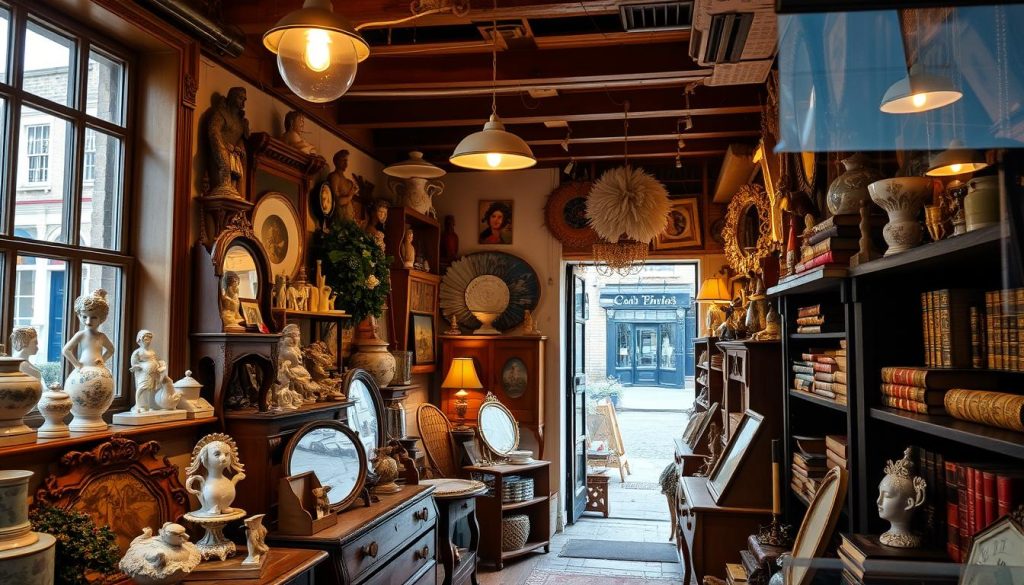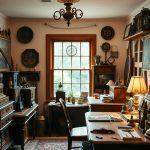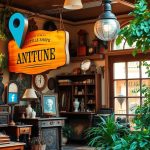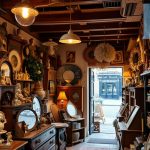Starting an antique business in the UK is a rewarding journey, especially with the growing interest in antiques. This guide is here to help those starting out. It covers everything from market trends to legal needs and finding real antiques. With the chance for good profits, antiques not only bring in money but also help keep history and culture alive.
Jump into this detailed guide and discover how to make your antique business a success.
Key Takeaways
- Understanding the UK antique market is crucial for success.
- Legal requirements are essential when starting an antique business.
- Effective sourcing strategies are key to finding authentic antiques.
- Pricing strategies should reflect condition and rarity.
- Marketing effectively can enhance visibility and attract customers.
- Building relationships with suppliers and collectors is vital for growth.
Understanding the Antique Market in the UK
The UK antique market has seen big changes in recent years. These changes come from new consumer tastes and the economy. Now, there’s a big interest in vintage collectibles for home décor and as investments. Young collectors are leading this trend, looking for items that show off their style and support sustainability.
Important antique fairs and well-known auction houses are key to the market. Events like the Antiques for Everyone fair and houses like Christie’s and Sotheby’s let people connect with the market. Online sites like eBay and special antique websites have made it easier for everyone to find a wide range of items.
Knowing how to value antiques is key for those in the market. The value depends on how rare it is, its condition, and its history. Sharing knowledge with others in the antique world helps sellers and buyers. It makes them more confident and knowledgeable in their dealings.
- Increased interest from younger generations
- Expanded access through online marketplaces
- Importance of antique fairs and auction houses
- Significant role of networking and community knowledge
The antique market is always changing. Keeping up with trends and understanding how to value antiques helps both new and experienced collectors. This knowledge is key to their success.
How to Start an Antique Business
Starting an antique business needs careful planning and smart thinking. You must create a strong business plan that covers important areas like niche markets and target customers. Knowing what collectors like helps decide which antiques to sell, which affects profits.
Choosing the right business model is crucial. Options include a physical shop, an online store, or both. Each choice has its own benefits and challenges. It affects how you connect with customers and grow your business.
Branding is key to making your business stand out. Pick a name that matches the antiques you sell and the people you want to attract. A strong brand helps with customer recognition and builds lasting relationships.
Doing deep market research is essential. It helps understand pricing and potential partnerships. This knowledge leads to better decisions and a strong market position. Antique dealers should mix creativity with practicality in their planning.
Essential Legal Requirements for Your Antique Business
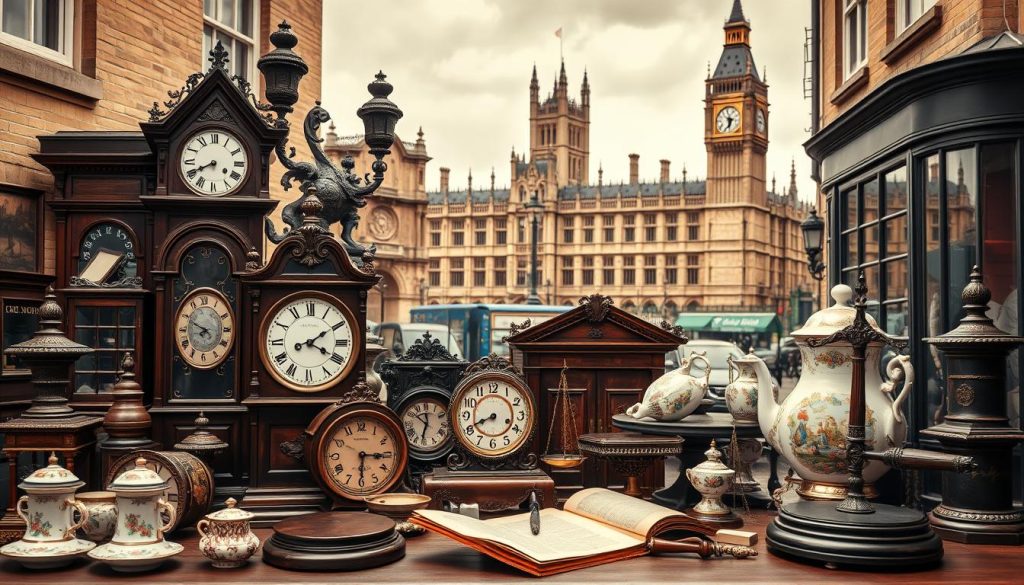
Starting an antique business in the UK means you must follow many legal rules. You need to register and get the right licences to begin. This includes registering your business with Companies House or as a sole trader.
What licences you need depends on what antiques you sell. For example, there are special rules for cultural property. Knowing these laws helps protect your business from legal problems.
You also need to think about VAT (Value Added Tax). If your business makes more than a certain amount, you must register for VAT. This affects how you price things and what customers expect to pay. Not following the rules can lead to big fines.
It’s important to follow consumer protection laws too. You must be clear about the condition, history, and realness of what you sell. Being honest builds trust with customers, which is key for a successful business.
Keeping detailed records of where antiques come from is crucial. These records prove the antiques are real and come from where they say they do. Being open about where things come from lowers legal risks and boosts your reputation in the antique world.
Sourcing Antiques: Where to Find Authentic Items
Finding antiques is key for those wanting to start an antique business. Knowing where to buy can greatly improve your stock. There are many ways to find real antiques, each offering different chances to grow your collection.
Estate sales are a treasure trove for rare pieces. Going to these sales lets dealers buy directly from families clearing out their homes, ensuring the item’s history. Antique fairs bring together many sellers in one place. These events make buying easy and offer chances to meet other collectors.
Online platforms have changed how people connect. Sites like eBay or special antique markets let you see more items and check sellers’ reputations. Being part of online forums can give you tips on finding antiques and spotting new trends.
Antique auctions are a top way to find rare items. To do well, you need to know the auction process. Keeping an eye on local auction houses and their schedules can help you find good deals.
Networking is crucial for finding antiques. Talking to private collectors can open up special chances. Joining antique groups gives you access to lots of information and lets you take part in events where rare items might be sold.
Think about the historical value and current trends when choosing items. Looking into popular styles and wanted pieces can help you make smart buys, keeping you in line with market trends.
| Sourcing Method | Advantages | Considerations |
|---|---|---|
| Estate Sales | Direct purchasing from owners; unique finds. | Limited time and competition for items. |
| Antique Fairs | Variety of sellers; networking opportunities. | Travel and entry fees might be required. |
| Online Platforms | Access to a wide range of items; convenience. | Potential for misrepresentation; seller ratings are crucial. |
| Antique Auctions | Access to rare items; potential for bargains. | Understanding of bidding process essential. |
| Networking with Collectors | Exclusive access to items; insider knowledge. | Building trust and relationships takes time. |
Evaluating Antique Condition and Authenticity
Knowing the condition and realness of antiques is key to their worth and making smart deals. Tools and resources help in checking their value well. These tools boost your skills in appraising antiques and help you make better choices.
Tools for Assessing Value
There are many resources to help evaluate antiques well. Here are the main tools for checking their value:
- Reference Books: These guides have lots of descriptions and pictures of antiques, helping you identify them correctly.
- Online Databases: Websites focused on antiques have databases with info on features, prices, and history for appraising.
- Professional Appraisers: Talking to experts in appraising antiques gives you insights into items and their market value.
Using these tools together helps with thorough research and making informed choices when appraising antiques.
Recognising Reproductions
It’s important to spot fakes and real antiques to keep the market honest. Here’s how to tell reproductions from the real thing:
- Look at the Materials: Real antiques use materials typical of their time. If an item looks too new or uses odd materials, it might be a fake.
- Check the Craftsmanship: Real antiques show great care in making them. Fakes often lack this attention to detail.
- Find Out the Provenance: Knowing an item’s history helps prove if it’s real. Be wary of items with no clear history.
Keeping up with new ways to make fakes is crucial for dealers and collectors. Museums and online forums are great places to learn more.
| Criteria | Genuine Antiques | Reproductions |
|---|---|---|
| Materials | Materials from the right time period | Modern materials or fake ones |
| Craftsmanship | High-quality, detailed work | Less care in making them |
| Provenance | Documents showing its history | Usually no solid history |
Pricing Strategies for Antiques
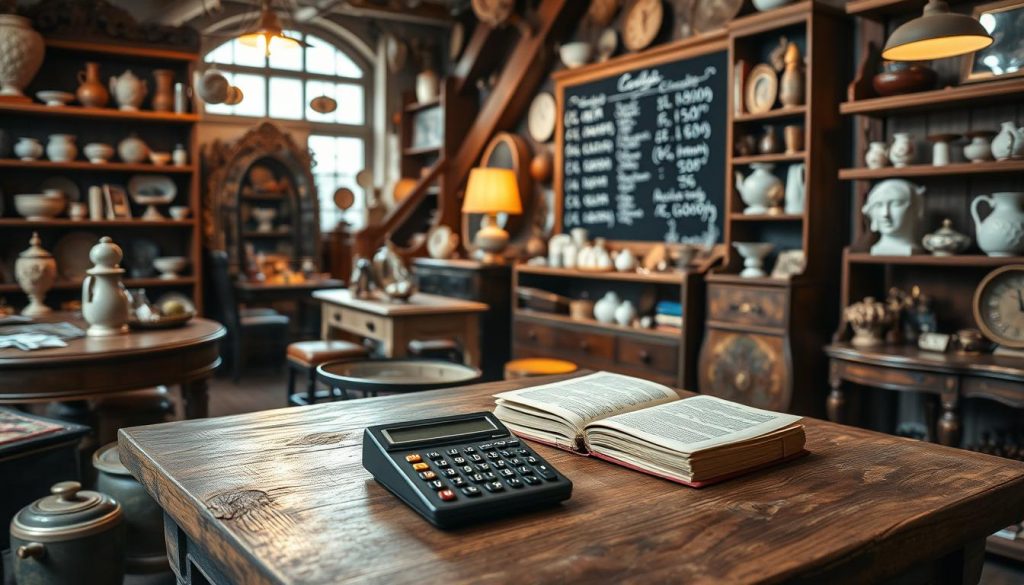
When you start selling antiques, setting the right prices is key. Doing thorough market research helps you find the best prices for your items. It’s important to know what similar items are selling for and what buyers expect to pay.
Market Research for Pricing
Market research is vital for setting competitive prices. By looking at similar items, you can see what they’re worth. Here are some steps to follow:
- Reviewing online auction sites like eBay for recent sales.
- Visiting local antique shops to see prices for yourself.
- Engaging with collector forums to hear what others think of market value.
This research gives you a clear idea of where your prices should be. A smart dealer uses this info to set prices that draw in buyers and make a profit.
Pricing based on Condition and Rarity
The state and rarity of antiques greatly affect their value. Pricing by condition helps you sort your items and make smart choices. Here’s a list to help you judge condition:
| Condition Category | Description | Impact on Pricing |
|---|---|---|
| Mint | Perfect condition, showing no wear. | Highest pricing potential. |
| Good | Minor imperfections, well maintained. | Above average pricing. |
| Fair | Visible wear and tear. | Below average pricing. |
| Poor | Significant damage, requires restoration. | Minimal pricing potential. |
Rarity also affects how much you can charge for antiques. Unique or limited items usually cost more. Knowing this helps dealers set prices that sell well and make a profit.
Setting Up Your Antique Store: Physical vs. Online
Deciding whether to have a physical or online antique store is a big choice. Each has its own pros and cons that affect how you run your business.
A physical store lets you meet customers face-to-face, helping build trust and increase sales. But, it comes with high costs like rent and staff, which can be tough for new businesses.
On the other hand, an online store is more flexible and cheaper to run. You can reach customers all over the world with digital marketing. A good website is key to showing off your antiques well. Good pictures and easy-to-use navigation are crucial to draw in customers.
The following table outlines key contrasts between a physical antique store and an online antique store:
| Aspect | Physical Antique Store | Online Antique Store |
|---|---|---|
| Customer Interaction | Personal, face-to-face communication | Virtual interactions with potential customers |
| Overhead Costs | Higher due to rent and utilities | Lower, primarily hosting and marketing fees |
| Inventory Management | Requires physical space management | Easier to manage and showcase online |
| Market Reach | Limited to local customers | Potentially global reach to customers |
In summary, both options for your antique business have their own benefits and challenges. It’s important to understand these differences to make a choice that fits your goals and resources.
Marketing Your Antique Business Effectively
Marketing antiques needs a mix of online and offline tactics. Using social media and local antique events can boost your business. These methods help increase visibility and get more customers involved.
Using Social Media to Attract Customers
Sites like Instagram and Facebook are great for promoting antiques. They let you show off your items and reach more people. Here are some tips to help you:
- Create visually appealing posts featuring high-quality images of your antiques.
- Use engaging captions that tell the story behind each piece.
- Utilise hashtags relevant to marketing antiques to increase reach.
- Engage with followers through comments, polls, and live sessions.
- Collaborate with influencers or brands within the antique niche.
Engaging with Local Antique Fairs and Shows
Local antique fairs and shows are great for meeting potential buyers. They let you connect with collectors and dealers in person. Here’s how to make the most of them:
- Prepare an attractive booth that highlights your unique offerings.
- Network with other exhibitors to exchange insights and customer leads.
- Offer promotional materials that encourage attendees to follow your social media profiles.
- Create an enticing display that captures the essence of your brand.
- Follow up with contacts made during the event for future collaborations.
Using social media and local antique fairs together can make your marketing strong. This mix of online and offline helps spread the word about your business.
Understanding Your Target Audience
In the world of antiques, knowing who buys them is key to success. Your customers can be collectors, interior designers, or people looking for unique decor. Each group has its own likes that affect how they shop.
To really connect with antique buyers, you need to understand what drives them. Some look for items with history or special meaning. Others love the look of vintage pieces. Knowing this helps shape what you sell and how you market it, making shopping with you better.
Here’s a look at the different types of people who buy antiques, what they like, and why they buy:
| Customer Segment | Key Characteristics | Buying Motivations |
|---|---|---|
| Collectors | Passionate about specific styles or eras; often knowledgeable | Seeking rare finds and investment opportunities |
| Interior Designers | Focus on aesthetic appeal; interested in unique statement pieces | Enhancing clients’ spaces with distinctive items |
| Casual Buyers | Lesser knowledge of antiques; often purchasing for personal use | Desire for character and nostalgia in their decor |
Knowing who buys antiques helps you pick the right items and market them well. This way, your business connects with potential customers. It builds strong relationships and keeps customers coming back.
Building Relationships with Suppliers and Collectors
For success in the antique business, it’s key to build strong supplier relationships. These connections help dealers get authentic items and ensure they are of high quality and reliable. Networking in antiques can lead to partnerships that improve your stock and give you insights into market trends.
To build meaningful relationships, consider these strategies:
- Attend Antique Fairs and Exhibitions: These events are great for networking. Meeting suppliers and other collectors can open up new opportunities.
- Join Antique Associations: Being a member of antique groups lets you share resources and contacts. It helps improve your supplier relationships.
- Maintain Open Communication: Keeping in touch with suppliers regularly builds trust. It also makes it clear what you expect from each other on quality and price.
- Offer Value Back: Help suppliers by showcasing their items in your store or promoting them online. This builds strong, mutual relationships.
Having a solid network is crucial. Antique collectors look for trust and authenticity. A reputable network of suppliers helps dealers meet these needs. Spend time on these relationships to keep your antique business thriving.
Financial Considerations for Your Antique Business
Starting an antique business needs careful financial planning. It’s key to know the costs involved to succeed in this market. A good budget helps you manage your money well, covering all your expenses.
Budgeting for Start-Up Costs
Creating a detailed budget is crucial for managing your initial costs. You’ll need to think about:
- Buying inventory
- Renting a shop
- Marketing and promotions
- Licences and permits
- Creating a website (if needed)
These costs add up to your total financial plan for antiques. Make sure to estimate costs well and have a backup fund for surprises. This way, you can run your business with confidence.
Managing Cash Flow in Your Business
Keeping an eye on your cash flow is key to your business’s success. Regularly check your income and spending to keep things healthy. Here are some tips:
- Open a separate business bank account
- Use accounting software for tracking expenses
- Send out invoices on time and chase up payments
- Plan for slow sales periods
These steps help you manage your finances well. They make forecasting your cash flow easier. Being ahead in managing cash can save your business from financial trouble.
| Expense Type | Estimated Cost (£) |
|---|---|
| Inventory Purchase | 1,500 |
| Rental Space | 800 |
| Website Development | 500 |
| Marketing | 300 |
| Licences and Permits | 200 |
Insurance and Protection for Your Antique Inventory
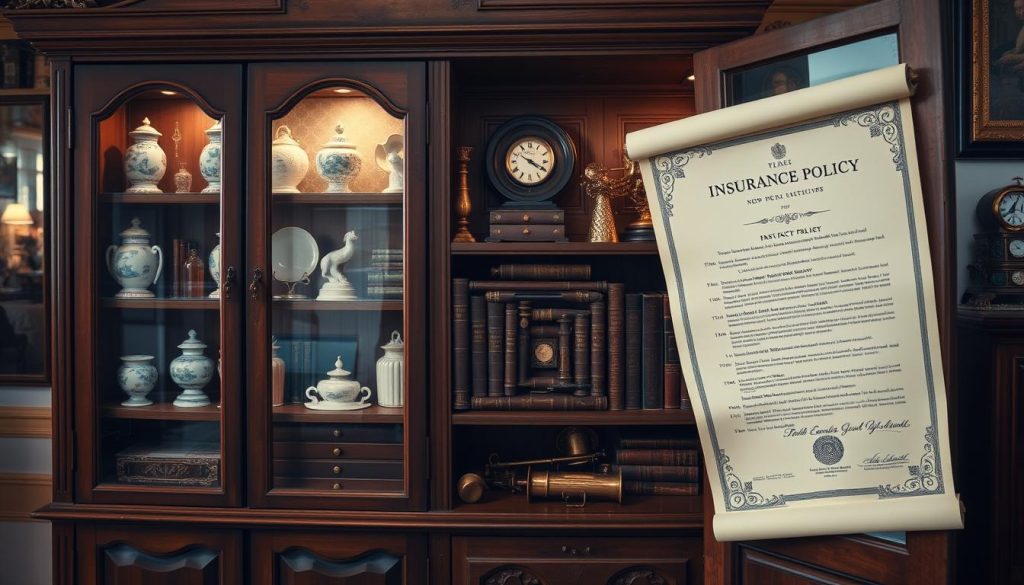
Owning an antique business means you face risks with valuable items. Antique inventory insurance is key to protect against theft, damage, and loss. It keeps your investment safe. Knowing about business insurance for antiques helps you manage risks.
There are many insurance options for antique dealers. Liability coverage is crucial, protecting you from injury or damage claims. You can also get policies for your inventory, covering theft or damage to antiques.
When figuring out insurance values, getting professional appraisals is crucial. Experts can tell you what your antiques are worth. This helps set the right coverage levels and makes handling claims easier.
Choosing antique inventory insurance is a smart move for your business. With the right protection, you can grow your collection and serve your customers better.
Trends in the Antique Market: Staying Ahead
For any aspiring dealer, knowing the antique market trends is key. Today, there’s a big move towards sustainability. People want items that have a good story, especially if they’re ethically sourced. This change is making the future of antiques exciting, as buyers look for pieces that match their values.
Virtual auctions are also on the rise. Now, traditional auction houses are going online, reaching people all over the world. Dealers need to get with the times and use technology to stay ahead. It’s about using new ways to sell while keeping the old-school charm.
There’s a growing love for vintage items over modern furniture. This could mean mid-century modern pieces are coming back in style. Antique dealers should think about adding these items to their stock. This way, they can draw in today’s buyers and keep their business fresh.
| Trend | Description | Impact on Dealer Strategies |
|---|---|---|
| Sustainable Sourcing | Emphasis on ethically sourced antiques | Focus on storytelling and provenance |
| Virtual Auctions | Increase in online bidding platforms | Adopt digital marketing solutions |
| Vintage over Modern | Shift towards vintage items gaining popularity | Adapt inventory to feature sought-after styles |
In conclusion, keeping an eye on these trends is crucial for antique dealers. The future looks bright for those who innovate and stay in tune with what buyers want.
Challenges You Might Face as an Antique Dealer
Starting an antique business is thrilling, but it comes with its own set of challenges. One big issue is the changing market prices. This makes it hard to know the real value of items. Knowing when to buy or sell is key in this ever-changing market.
There’s also a lot of competition, both locally and online. With many platforms to sell on, it’s important to stand out. This means offering something unique to attract customers.
Another challenge is the need to keep learning. It’s vital to know about trends, history, and how to value items. This knowledge helps you manage the business better. Many dealers recommend taking workshops or getting formal training to stay on top of things.
Overcoming these hurdles requires being resilient and flexible. Building connections in the antique world can offer valuable advice and support. As one dealer said, “Being part of a network lets you share tips and insights, which can be a game-changer.”
Understanding these challenges early can set a strong base for your antique business. It prepares you for the ups and downs ahead.

